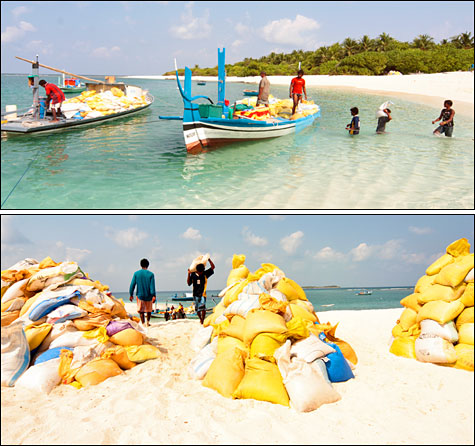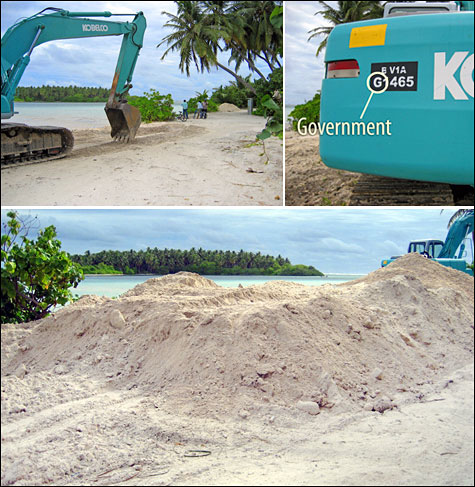SAND MINING MIGHT ERASE SOME ISLANDS FROM MAP OF MALDIVES
Since time immemorial artisanal coral sand extraction or mining from local beaches and lagoons, mainly for construction purposes, has been a common practice in the Maldives. However, within the last four decades the Maldives has been experiencing a massive boom in the construction of cement houses and high-rise concrete buildings. Up to late 1980s, almost all the cement houses and buildings were built with coral sand and coral aggregates from local beaches and lagoons. In the late 1980s, imports of river sand and aggregates from India started to replace coral sand and coral aggregates in the construction of high-rise buildings.

“UNEP’s field mission found that artisanal extraction of coral sand from lagoons (manually using sacks was evident at nearly all the islands visited. UNEP witnessed uncontrolled coral sand exploitation, and visual evidence indicates that coral sand extraction has increased since the tsunami.” (Maldives Post-Tsunami Environment Assessment Report)
India has over the years allowed the exports of these commodities to the Maldives under a special arrangement which has placed an exception on those commodities which are otherwise prohibited to be exported from India. Last year 300,000 MTs of river sand and 270,000 MTs of aggregates were allowed to be imported to Maldives from India. However, post tsunami reconstruction boom associated with developing more resorts have created a shortage of river sand. Thus the price of river sand rose from around RF490 (US$38) per ton to RF900 (US$70). Furthermore, the recent hike in prices of oil in the international market has increased the transportation costs of these commodities as well.
In 2008, India has increased the limit on export of construction materials – river sand by 30 per cent and stone aggregate by 95 per cent – to Maldives. However, the prices of river sand and aggregates have not come down.
Since most of the outer islands in the Maldives have no easy access to river sand and aggregates, the people have to get these commodities from Male’ region, and it’s too expensive to transport these commodities due to lack of a proper inter-island transport network. Poor islanders are left with no choice but mine coral sand from their own beaches even though it is prohibited.
In order to reduce the coral sand extraction from the local beaches and lagoons, it is imperative to make river sand and aggregates available nation-wide, of course, with subsidised prices, and also make available coral sand extracted during harbour dredging, in different sizes and qualities, that could be use for construction purposes.
What is ironic is that coral sand has been mined from some islands for the post tsunami reconstruction, further making these islands more vulnerable for erosion, sea level rise and storm surges. Even though sand extraction is prohibited from beaches of inhabited islands, it has been witnessed that the Government and internationals donors funded some projects involving extraction of coral sand.

Non-artisanal beach mining of Seenu Feydhoo’s southern side beach with the help of the Government earth moving vehicle to expand Feydhoo’s cemetry.
Photo: www.oursda.org
According to the “Maldives Post-Tsunami Environment Assessment Report” published by UNEP, ” A review of sand mining regulations from other countries that are less vulnerable to sea level rise and storm surges than the Maldives, France, UK, Japan, Netherlands and USA indicates sand mining in those countries is restricted to depths greater than 10m and at minimum distance from shore of 600 metres (See, e.g., www.seafriends.org.nz/oceano/seasand.htm). It is not known if the restrictions placed on beach sand mining in the Maldives have been assessed to determined their ability to protect islands from increased vulnerability.”
If coral sand mining along with other forms of coastal modification continues at the present rates, some of islands in the Maldives would be eroded due to these unwise activities. The coastal degradation caused by such undesirable activities have to be countered through protective measures that cost millions of dollars such as concrete coastal defence structures like the one around Male’. Uncontrolled sand mining has caused severe beach erosion in islands such as Fuvahmulah, and costly remedies in the form of coastal walls are in the pipeline.

“Although official statistics shows dramatic reductions in the total volumes of sand and coral extracted this may be due to the under-reporting of a now-illegal activity rather than a substantial reduction in demand.” (Maldives Post-Tsunami Environment Assessment Report)
It is pathetic that some of the islands might be erased from the map of Maldives because of our local actions much before forecast sea level rise due to global warming. If not for India’s river sand and aggregates, some of the islands might have already vanished through unreported illegal excessive mining of coral sand from the local beaches and lagoons. With the special arrangement, India is helping to save our islands from erosion by providing a substitute to coral sand and coral aggregates. One could argue that a part of India’s carbon emission could be traded off with this generous gesture to its low-lying neighbour, the Maldives.
